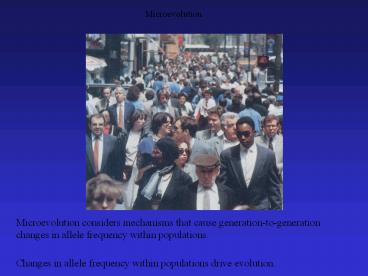Microevolution - PowerPoint PPT Presentation
1 / 30
Title:
Microevolution
Description:
Microevolution Microevolution considers mechanisms that cause generation-to-generation changes in allele frequency within populations. Changes in allele frequency ... – PowerPoint PPT presentation
Number of Views:108
Avg rating:3.0/5.0
Title: Microevolution
1
Microevolution
Microevolution considers mechanisms that cause
generation-to-generation changes in allele
frequency within populations.
Changes in allele frequency within populations
drive evolution.
2
Populations, Allele Frequency Change, and
Microevolution
A population is a group of interbreeding
organisms present in a specific location at a
specific time.
Allele frequency is the frequency of a particular
allele in the population.
The population, not the species or individual, is
the fundamental unit of evolution.
3
Populations Are the Units of Evolution
4
The Genetic Basis of Evolution
For evolution to occur, genetic differences must
at least partially account for phenotypic
differences.
5
What Drives Evolution?
There are 5 forces of change.
Only natural selection makes a population better
adapted (more fit) to its environment.
6
Mutations Provide Raw Material For Evolution
Mutations are usually neutral or harmful in their
effects only rarely are they beneficial.
7
Mutations Just Happen
Mutations occur at random without regard to
whether they have a beneficial, neutral or
harmful effect.
For this reason, mutations are a randomly acting
evolutionary force.
8
Mutation
Mutation is the only source of new alleles in a
species.
Mutation acting alone works too slowly to drive
evolution.
With an average mutation rate, it takes 70,000
generations, far more than the number of
generations of modern humans, to reduce allele
frequency by 50.
9
Gene Flow or Migration
Gene flow makes separate populations more similar
genetically.
The effects of gene flow are seen in many human
populations, including the U.S. population.
Gene flow in plants wind-dispersed pollen
moving between Monterey pines.
10
Gene Flow or Migration
11
Genetic Drift
Genetic drift is random fluctuation in allele
frequency between generations.
The effects of genetic drift are pronounced in
small populations.
12
A Genetic Bottleneck is a Form of Genetic Drift
In a genetic bottleneck, allele frequency is
altered due to a population crash.
Once again, small bottlenecked populations big
effect.
13
Genetic Bottleneck A Historical Case
Note A genetic bottleneck creates random genetic
changes without regard to adaptation.
A severe genetic bottleneck occurred in northern
elephant seals.
Other animals known to be affected by genetic
bottlenecks include the cheetah and both ancient
and modern human populations.
14
Endangered Species Are in the Narrow Portion of a
Genetic Bottleneck and Have Reduced Genetic
Variation
15
The Effect of Genetic Drift is Inversely Related
to Population Size
16
The Founder Effect is Another Variation of
Genetic Drift
A founder effect occurs when a small number of
individuals from one population found a new
population that is reproductively isolated from
the original one.
17
The Founder Effect is Another Variation of
Genetic Drift
The South Atlantic island of Tristan da Cunha was
colonized by 15 Britons in 1814, one of them
carrying an allele for retinitis pigmentosum.
Among their 240 descendents living on the island
today, 4 are blind by the disease and 9 others
are carriers.
18
The Founder Effect
Old Order Amish populations are derived from a
few dozen colonists who escaped religious
persecution in Germany in 1719 to settle in
Pennsylvania.
The community is closed.
Allele and genetic disease frequencies in Amish
are significantly different from the German
ancestral and the surrounding local populations.
19
The Founder Effect
20
Non-Random Mating
Non-random mating occurs when there is a bias for
or against mating with related individuals.
Cute, but prone to genetically-based disorders.
Inbreeding is preferential mating with relatives.
Inbreeding is a common form of non-random mating.
Inbreeding increases the frequency of
homozygosity relative to random mating, elevating
the frequency of recessive genetic disorders.
21
Non-Random Mating
The high frequency of particular recessive
genetic disorders seen in many closed communities
is a consequence of the founder effect and
inbreeding.
Remember that inbreeding includes matings of
distant relatives the Amish have never
practiced marriage between sibs or other
immediate relatives.
22
Natural Selection
Natural selection leads to adaptation an
increase in the fitness of a population in a
particular environment.
Natural selection works because some genotypes
are more successful in a given environment than
others.
Successful (adaptive) genotypes become more
common in subsequent generations, causing an
alteration in allele frequency over time that
leads to a consequent increase in fitness.
23
Three Forms of Natural Selection
24
Directional Selection
Hominid Brain Size
25
A Galapagos Finch, the Subject of a Classic Study
of Evolution in Action
Peter and Mary Grant and their colleagues
observed how beak depth, a significant trait for
feeding success, varied in populations
experiencing climactic variations.
26
Beak Depth Changed in a Predictable Way in
Response to Natural Selection
Significantly, beak depth is a genetically
determined trait.
27
Human Birth Weight Is Under Stabilizing Selection
Modern medicine relaxes this and other forms of
selection.
28
Stabilizing Selection for the Sickle Cell Allele
In heterozygous form, the sickle cell allele of
?-globin confers resistance to malaria.
Therefore, the allele is maintained, even though
its harmful in homozygous form.
29
Changing Selection With Changes in Human Culture?
30
Changing Selection With Changes in Human Culture?































